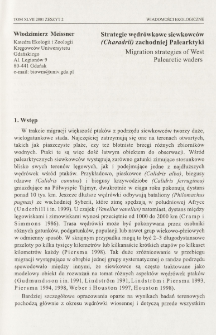
Object
Title: Strategie wędrówkowe siewkowców (Charadrii) zachodniej Palearktyki
Subtitle:
Strategie wędrówkowe siewkowców ; Migration strategies of West Palearctic waders
Contributor:
Polska Akademia Nauk. Instytut Ekologii
Publisher:
Oficyna Wydawnicza Instytut Ekologii PAN
Place of publishing:
Description:
Pages 119-141 ; 24 cm ; Bibliographical references (pages 135-141) ; Abstract in English
Type of object:
Abstract:
Among Palearctic waders (Charadrii) there are species that winter relatively close to their breeding grounds, as well as those that undertake one of the longest migrations among birds. The majority of them are not able to cross the whole distance between breeding and wintering grounds in one long-distance flight. They divide the migration route into several or even over a dozen of steps between which they stay in areas abounding in food. In stopover sites birds accumulate fat and proteins. Fat is the main source of energy, while proteins indirectly take part in oxidation of fatty acids.Two main migration strategies were defined. Birds that realise the time-minimisation strategy cross long distances accumulating large fat reserves in stopover sites. They reach the destination of migration very quickly, but their total energetic expense on migration is very high due to the high cost of flight with large fat supply. The strategy of energy-minimisation is realised by migration with Iow fat reserves, short stops at stopover sites and short-distance flights. Migration speed is Iow in this case, but also the overall energetic costs of migration are relatively Iow. It was also shown that waders could change the realised migration strategy within a season. The mechanism of the choice of the realised migration strategy acts at the level of individuals. Each bird takes the decision to depart from a stopover site individually on the basis of information coming from the surrounding environment (the quality of a feeding ground, inter- and intraspecific competition for habitat resources, weather, predation pressure), and of its physiological stage (the amount of accumulated fat reserves and the ratę of their accumulation). As these factors at a given stopover site usually influence on many individuals in a similar physiological stage in the same way, a whole flock takes off to the next step of the migration.A bird probably can assess the quality of a feeding ground according to foraging success. Basing on it, the individual takes the decision to depart quickly with Iow fat deposit (energy-minimising strategy) or to stay and accumulate large fat reserves allowing for a long-distance flight (time-minimising strategy). According to the quality of the next feeding site the individual can continue realised strategy or change it. Young birds during their first migration visit by a principle of trial and error many potential feeding grounds. The strategy of minimising the energetic expense allows them for using feeding sites even of a Iow abundance, on condition that such areas are relevantly numerous and they are not too distant from each other.
Relation:
Volume:
Issue:
Start page:
End page:
Detailed Resource Type:
Resource Identifier:
oai:rcin.org.pl:225374 ; 0013-2969
Source:
MiIZ PAN, call no. P.3259 ; click here to follow the link
Language:
Language of abstract:
Rights:
Creative Commons Attribution BY 3.0 PL license
Terms of use:
Copyright-protected material. [CC BY 3.0 PL] May be used within the scope specified in Creative Commons Attribution BY 3.0 PL license, full text available at: ; -
Digitizing institution:
Museum and Institute of Zoology of the Polish Academy of Sciences
Original in:
Library of the Museum and Institute of Zoology of the Polish Academy of Sciences
Projects co-financed by:
Access:
Object collections:
Last modified:
Feb 4, 2022
In our library since:
Oct 28, 2021
Number of object content downloads / hits:
138
All available object's versions:
https://rcin.org.pl/miiz/publication/173246
Show description in RDF format:
Show description in RDFa format:
Show description in OAI-PMH format:
| Edition name | Date |
|---|---|
| Z. 2. Strategie wędrówkowe siewkowców (Charadrii) zachodniej Palearktyki / Meissner W. | Feb 4, 2022 |
Objects Similar
Busse, Przemysław (1937– ) Halastra-Petryna, Grażyna
Meškov, Mihail Mihajlovic (1909– ) Urâdova, Ludmila P.
Busse, Przemysław (1937– ) Gromadzki, Maciej (1940– ) Szulc-Olechowa, Bogumiła (1941– )
Kania, Wojciech Maria (1943– )
Józefik, Mieczysław (1930– )
Zając, Ryszard Zygmunt (1936– )

 INSTYTUT ARCHEOLOGII I ETNOLOGII POLSKIEJ AKADEMII NAUK
INSTYTUT ARCHEOLOGII I ETNOLOGII POLSKIEJ AKADEMII NAUK
 INSTYTUT BADAŃ LITERACKICH POLSKIEJ AKADEMII NAUK
INSTYTUT BADAŃ LITERACKICH POLSKIEJ AKADEMII NAUK
 INSTYTUT BADAWCZY LEŚNICTWA
INSTYTUT BADAWCZY LEŚNICTWA
 INSTYTUT BIOLOGII DOŚWIADCZALNEJ IM. MARCELEGO NENCKIEGO POLSKIEJ AKADEMII NAUK
INSTYTUT BIOLOGII DOŚWIADCZALNEJ IM. MARCELEGO NENCKIEGO POLSKIEJ AKADEMII NAUK
 INSTYTUT BIOLOGII SSAKÓW POLSKIEJ AKADEMII NAUK
INSTYTUT BIOLOGII SSAKÓW POLSKIEJ AKADEMII NAUK
 INSTYTUT CHEMII FIZYCZNEJ PAN
INSTYTUT CHEMII FIZYCZNEJ PAN
 INSTYTUT CHEMII ORGANICZNEJ PAN
INSTYTUT CHEMII ORGANICZNEJ PAN
 INSTYTUT FILOZOFII I SOCJOLOGII PAN
INSTYTUT FILOZOFII I SOCJOLOGII PAN
 INSTYTUT GEOGRAFII I PRZESTRZENNEGO ZAGOSPODAROWANIA PAN
INSTYTUT GEOGRAFII I PRZESTRZENNEGO ZAGOSPODAROWANIA PAN
 INSTYTUT HISTORII im. TADEUSZA MANTEUFFLA POLSKIEJ AKADEMII NAUK
INSTYTUT HISTORII im. TADEUSZA MANTEUFFLA POLSKIEJ AKADEMII NAUK
 INSTYTUT JĘZYKA POLSKIEGO POLSKIEJ AKADEMII NAUK
INSTYTUT JĘZYKA POLSKIEGO POLSKIEJ AKADEMII NAUK
 INSTYTUT MATEMATYCZNY PAN
INSTYTUT MATEMATYCZNY PAN
 INSTYTUT MEDYCYNY DOŚWIADCZALNEJ I KLINICZNEJ IM.MIROSŁAWA MOSSAKOWSKIEGO POLSKIEJ AKADEMII NAUK
INSTYTUT MEDYCYNY DOŚWIADCZALNEJ I KLINICZNEJ IM.MIROSŁAWA MOSSAKOWSKIEGO POLSKIEJ AKADEMII NAUK
 INSTYTUT PODSTAWOWYCH PROBLEMÓW TECHNIKI PAN
INSTYTUT PODSTAWOWYCH PROBLEMÓW TECHNIKI PAN
 INSTYTUT SLAWISTYKI PAN
INSTYTUT SLAWISTYKI PAN
 SIEĆ BADAWCZA ŁUKASIEWICZ - INSTYTUT TECHNOLOGII MATERIAŁÓW ELEKTRONICZNYCH
SIEĆ BADAWCZA ŁUKASIEWICZ - INSTYTUT TECHNOLOGII MATERIAŁÓW ELEKTRONICZNYCH
 MUZEUM I INSTYTUT ZOOLOGII POLSKIEJ AKADEMII NAUK
MUZEUM I INSTYTUT ZOOLOGII POLSKIEJ AKADEMII NAUK
 INSTYTUT BADAŃ SYSTEMOWYCH PAN
INSTYTUT BADAŃ SYSTEMOWYCH PAN
 INSTYTUT BOTANIKI IM. WŁADYSŁAWA SZAFERA POLSKIEJ AKADEMII NAUK
INSTYTUT BOTANIKI IM. WŁADYSŁAWA SZAFERA POLSKIEJ AKADEMII NAUK
































